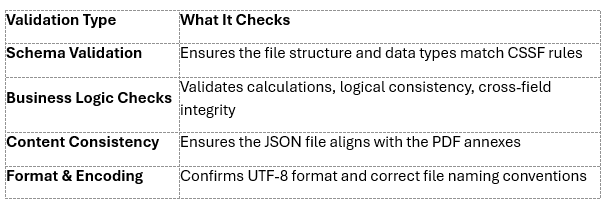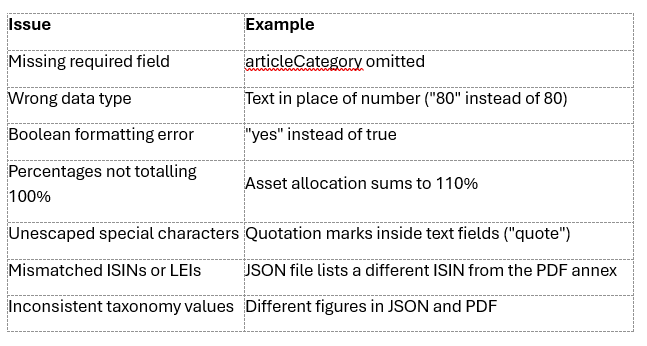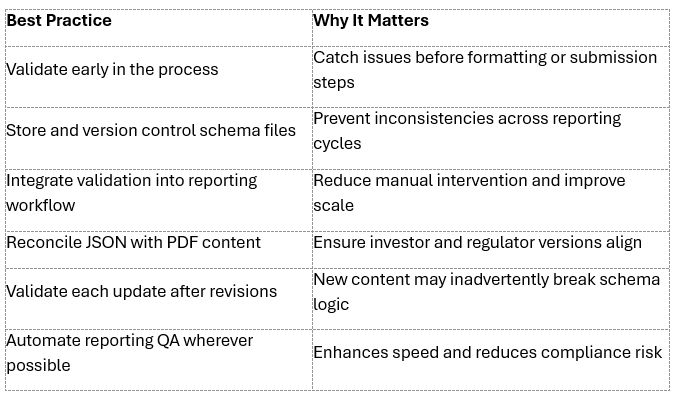
Validating your SFDR JSON: Tools, checks, and best practices
Successfully submitting SFDR Annex documents to the CSSF hinges on one critical process: JSON validation. This article delves into the tools and techniques necessary to validate your SFDR JSON files effectively, helping asset managers prevent costly errors and compliance setbacks.
With the CSSF’s mandatory SFDR JSON submission now fully in force, the difference between a smooth regulatory filing and a last-minute rejection often comes down to one step: validation.
Even a perfectly constructed SFDR Annex II or Annex V document can fail if the corresponding JSON file contains technical errors, schema mismatches, or inconsistent data. To avoid rework, reputational risk, or missed deadlines, asset managers must incorporate rigorous validation procedures into their SFDR reporting process.
This article outlines how to validate your SFDR JSON file, which tools to use, and which common issues to catch before submitting to the CSSF.
Why JSON validation matters
The CSSF eDesk platform validates your JSON file against a predefined schema, ensuring that:
- Required fields are present
- Values are correctly typed and formatted
- Data follows logical rules (e.g., percentages add up to 100%)
- The file structure matches the CSSF JSON model
If your file doesn’t pass, it will be rejected at upload, delaying submission and raising compliance concerns.
Types of validation you should perform

Recommended validation tools
- CSSF Schema + JSON Validator (Open Source Tools)
Use a standard JSON schema validator with the CSSF’s official schema file.
Tools:
- https://jsonschemavalidator.net
- Local via Python (jsonschema) or VS Code extensions
Steps:
- Download the latest CSSF schema (.json file).
- Upload your SFDR JSON file.
- Run the validation to identify errors, missing fields, or incorrect types.
2. Custom in-house QA scripts
If you're using Excel, ETL tools, or internal generators, ask your IT or reporting team to implement:
- Field-specific sanity checks (e.g., no negative percentages)
- Validation of mandatory narrative fields
- Alerting for missing PAI indicators or taxonomy values
3. Third-party RegTech Platforms
Many SFDR-focused vendors now include built-in validation engines that automatically check your JSON files prior to CSSF submission.
Benefits:
- Includes CSSF-specific validation logic
- Often offers side-by-side comparison with PDF annexes
- Can integrate into your reporting workflow
FE fundinfo makes sure that a specific validation schema is used for the required report. So, an Article 9 report follows a different validation than an Article 8 report. This ensures the highest possible quality for your JSON report.
Top 7 validation issues to watch for

Best practices for reliable JSON validation

Final submission checklist
Before uploading your file to CSSF eDesk, confirm:
- File is UTF-8 encoded
- Follows CSSF naming convention
- Matches the correct Annex type (II or V)
- Has passed schema and logical validation
- Aligns with submitted PDF annexes
- Includes all relevant PAI, taxonomy, and allocation fields
Conclusion: Quality control is compliance control
Validating your SFDR JSON isn’t just about ticking a technical box — it’s about ensuring regulatory confidence, investor transparency, and operational readiness. By using the right tools and embedding validation into your SFDR workflow, asset managers can submit with clarity, speed, and confidence.